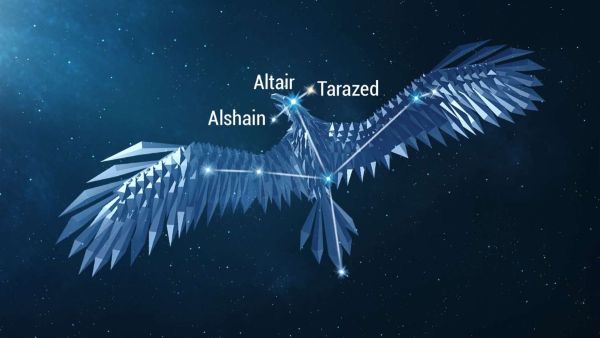Altair - Archetypal Analysis According to the Jungian Key
Altair – archetypal analysis according to the Jungian key
Altair , the brightest star in the constellation Aquila, occupies a special place in the symbolic landscape of the sky. In traditional astrology, it is associated with strength, speed and striving for heights – the characteristics of the eagle, a mythical bird that has been a mediator between the earthly and the divine since time immemorial.
In a Jungian perspective, Altair can be seen as an archetype of transcendence: the driver of the inner drive to transcend the limits of the personal ego and to touch the realm of higher meaning. The symbol of the eagle, which is associated with this star, reflects the process of individuation – rising from the “lower” instinctive spheres to consciousness, to a wider insight.
Mythologically , in the Greek tradition, the eagle was the sacred bird of Zeus, the bearer of lightning and divine will. In this sense, Altair can be seen as the inner voice of the numinous, that impulse that calls us to listen to something greater than our rational mind. Jung would recognize this as an experience of the Self, the center of the psyche that transcends the ego.
However, Altair’s speed and sharpness also carry a shadowy aspect. If the energy of the eagle is manifested unconsciously, it can lead to ego arrogance, a sense of superiority and isolation from the community. In this sense, Altair reminds us that the process of individuation is not flight to the heights, but integration – the eagle must know how to land, to connect heaven and earth.
Altair, therefore, can be read as an inner symbol of flight and fall, the vertical path along which the psyche travels towards its own wholeness. He challenges us to ask ourselves: do we use our own “wing power” to contact a higher meaning, or to avoid reality and abandon our roots in earthly life?
It is interesting that Manilius in the 1st century BC, in his work Astronomica, described the nature of the Eagle and its main star Altair in a way that strongly builds on the Jungian interpretation:
“The eagle rises high, the bird of mighty Jupiter that carries the lightning; it is a bird worthy of Jupiter and the sky itself, to which it provides a terrible weapon. It returns the lightning that Jupiter threw and fights in the service of the sky.
He who is born at the hour of its rise will become a man turned to prey and he plunders, and that often by the shedding of blood; he will not distinguish between the citizen and the enemy, and when he runs out of men to kill, he will turn to the slaughter of animals, and rush to where his desire leads him;
yet, if his vehemence is directed to a just cause, he will succeed in bringing wars to an end and making his country rich. triumphs as the Eagle does not use, but brings weapons — for he returns and delivers to Jupiter the lightnings and fires which the latter has thrown — in times of war such a man will be the ally of a king or a mighty general, and his strength will be of great help to them.”
This one the ancient description emphasizes the same duality recognized by Jungian psychology: the eagle can be a symbol of greed, aggression, and power intoxication, but also an instrument of a higher order when its power is directed toward a righteous goal. In this sense, Manili’s painting of Altair confirms that it is an archetypal pattern – an inner pattern of the human psyche, present even before Jung, which speaks of the necessity of integrating the instinctive and the spiritual, the instinctive and the numinous, in order to reach wholeness.
Altair, the Eagle and Christian Symbolism
In the Christian tradition, the eagle appears as a symbol of the Evangelist John. His Gospel begins with the words of the Logos, “in the beginning was the Word,” and rises to divine revelation more than any other text of the New Testament. Jung would say that here the eagle is an image of spiritual intuition – the ability to look above the earthly, to see the whole and the divine order. Altair as a star in this key reflects the inner faculty of vision: to see that which transcends the linear logic of the ego.
However, the Christian eagle is not just soaring. He also stands for the power of faith that can carry the human soul to salvation. Jungian, this is a process of transformation of the unconscious into consciousness, where the eagle becomes a mediator between earth (matter, instinct) and heaven (spirit, numinous). Shamanic Flight and the Eagle as a Guide
In shamanic traditions around the world, the eagle is a bird of ecstasy. He leads the shaman in a trance through the “upper worlds”, towards the divine sources of knowledge. The shaman “flies” on eagle’s wings and returns with messages and healing powers for the community. This symbol is extremely Jungian: it represents active imagination, a process in which the psyche travels through inner landscapes to bring insight and energy back into conscious life.
In this context, Altair can be seen as an inner point of vision – a star that invites us to travel to the unconscious, but also obliges us to return, to translate the experience into life. If a man gets lost in flight, he remains trapped in fantasy; if he returns, he brings light to the community.
Jungian synthesis
Combining ancient myth (Manilius’ eagle), Christian symbol (John’s eagle) and shamanic flight, we see that Altair always carried the archetypal function of a mediator: between god and man, heaven and earth, unconscious and consciousness.
As Manilius showed, his power can be wild, destructive, and intoxicated with power.
As the Christian symbol suggested, she can become a vision of the divine Logos.
As shamanic practice has revealed, it is the power of imagination and transformation that brings insight from the unconscious into the collective.
Altair thereby teaches us a fundamental lesson of Jungian psychology: there is no pure ascension without integration. An eagle can fly, but it must also land; vision without rootedness leads to illusion, and force without meaning leads to destruction. Only their union opens the door to individuation – the process through which a person becomes whole.
Altair in astrology – Jungian application
Altair (α Aquilae) in natal astrology is located at about 1–2° Aquarius (in the tropical zodiac, for our time). As a fixed star, it is most often interpreted when conjunct personal planets, the Ascendant, or the MC (1–2° orb).
The main themes of Altair
are willpower and striving for heights,
speed and courage,
spiritual vision and intuition,
potential for success through powerful patrons or cooperation with leaders,
danger of hubris, excessive arrogance and isolation.
In a Jungian key, this means that Altair activates the eagle archetype – an inner image that pushes us towards transcendence, but which can become dangerous if appropriated by the ego.
Altair in aspect with the planets
Sun – A sense of personal mission, a vision of one’s own role in the world. In Jungian terms: the ego seeks connection with the Self, but risks identifying with the divine and falling into inflation.
Moon – Unconscious images of summer and fall, rich inner symbolic life. The need to feed the soul with “higher” experiences.
Mercury – Quick mind, prone to inspiration and intuition, but also excessive sharpness in words. Jungian: the voice of the animus or inner guide.
Venus – Ideals in love and aesthetics, striving for “divine love”. Risk: contempt for ordinary, everyday relationships.
Mars – Courage of the warrior, vision of victory. Shadow: violence, impudence, enjoyment of domination.
Jupiter – Alliance with higher powers, the possibility for a person to be a “armored” leader or to become an authority himself. Archetypal: service to the numinous.
Saturn – Test of power: will the flight be stable or will the wings break? Jungian: confrontation with the Shadow and the limits of the ego.
Ascendant/MC – The entire personality or social role marked by eagle symbolism: a visionary, a leader, but also one who carries the danger of hubris.
Altair as an inner dynamic (Jungian view)
In the practice of analysis, when Altair stands strong in the natal, it can be seen as an inner image of an eagle that requires work on integration:
If ignored, it appears as a projection – the person attracts powerful figures (leaders, authorities, mentors) who “carry his lightning”.
If over-identified, the ego can slip into inflation: a sense of having a divine mission, out of touch with reality.
If integrated, it brings the ability of visionary leadership: to translate what is seen from above into a form that helps the community.

